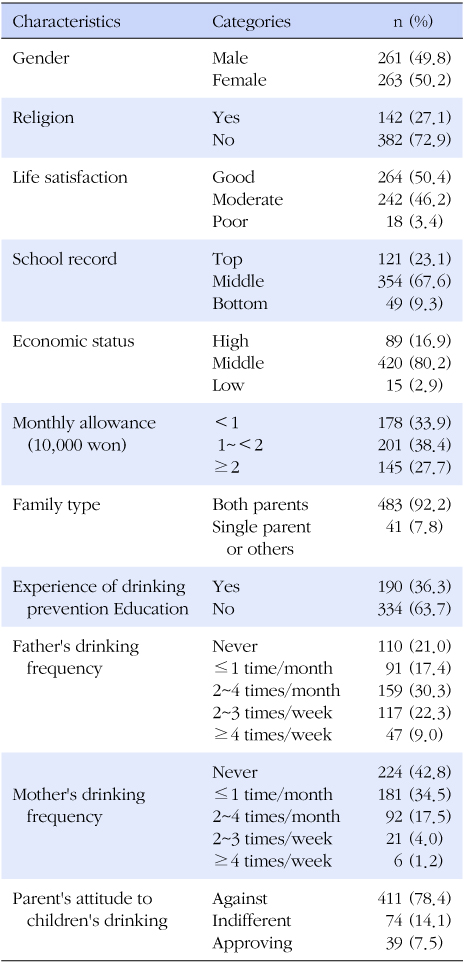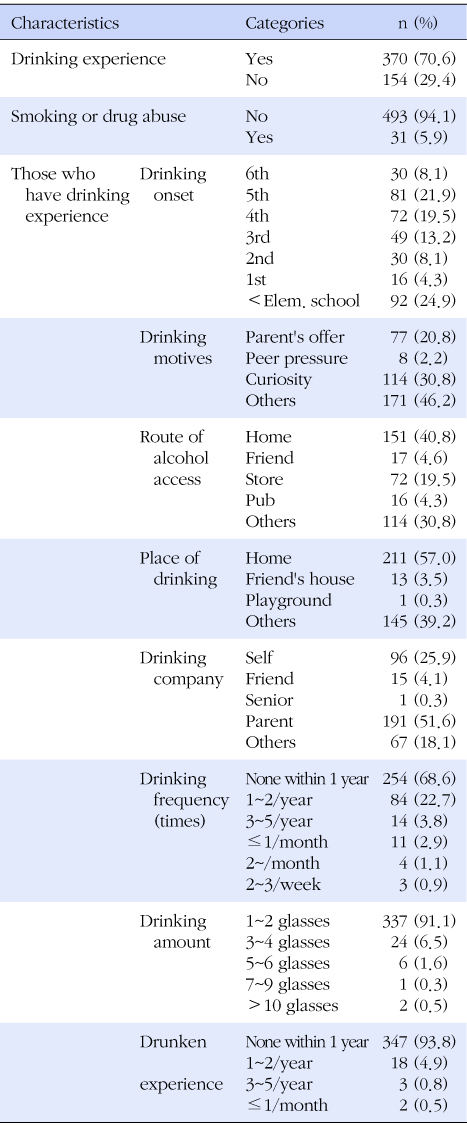Articles
- Page Path
- HOME > J Korean Acad Community Health Nurs > Volume 23(1); 2012 > Article
-
Original Article
- Factors Affecting Alcohol Drinking of Sixth-grade Children in South Korea
- Yeon Ran Hong, Eun Young Do
-
Journal of Korean Academy of Community Health Nursing 2012;23(1):63-70.
DOI: https://doi.org/10.12799/jkachn.2012.23.1.63
Published online: March 31, 2012
1Assistant Professor, Department of Nursing, Chodang University, Muan, Korea.
2Associate Professor, Department of Nursing, Kwangju Women's University, Gwangju, Korea.
• Received: October 30, 2011 • Revised: March 8, 2012 • Accepted: March 12, 2012
Copyright © 2012 Korean Academy of Community Health Nursing
- 574 Views
- 0 Download
- 3 Crossref
Abstract
-
Purpose
- The purpose of this study was to identify factors influencing 6th graders' alcohol drinking.
-
Methods
- Data were collected by questionnaires from 524 6th-graders in G City. The data were analyzed using SAS 9.1.3 programme.
-
Results
- Of the children, 63.7% had no education about drinking, implying that drinking prevention education is not done properly in elementary schools. In addition, 70.6% of the children experienced drinking. Among those who had drinking experience, 24.9% experienced the first drinking before entrance into elementary school and this was the highest percentage. Logistic regression analysis showed that the predictors are religion, family type, mother's drinking frequency, and alcohol attitude.
-
Conclusion
- The results of this study suggest that complementing home environment and parenting education would be effective for reducing children's drinking. Also, it is recommended that drinking prevention programs for children should be developed in consideration of various factors affecting children's drinking including the factors identified in the present study, and the effectiveness of those programs should be assessed.
- 1. American Public Health Association. Chronic disease and emergency department: A current review. Alcohol Alcohol 1998;37:307–312.
- 2. Alamian A, Paradis G. Correlates of multiple chronic disease behavioral risk factors in canadian children and adolescents. Am J Epidemiol 2009;170:1279–1289.
- 3. Stacy AW, Zogg JB, Unger JB, Dent CW. Exposure to televised alcohol ads and subsequent adolescent alcohol use. Am J Health Behav 2004;28:498–509.
- 4. Bancroft A, Wilson S. The risk gradient in policy on children of drug and alcohol users: Framing young people as risky. Health Risk Soc 2007;9:311–322.
- 5. Bandura A. Social learning theory 1977;Englewood Cliff, NJ: Prentice-Hall.
- 6. Blume AW, Lostutter TW, Schmaling KB, Marlatt GA. Beliefs about drinking behavior predict drinking consequences. J Psychoactive Drugs 2003;35:395–399.
- 7. Carver VC, Kittleson MJ, Andrews VJ. Assessing alcohol consumption attitudes of adolescent drinkers: Implications for alcohol education programs. J Health Behav Educ Promot 1991;15:32–36.
- 8. Cara ER, Danielle D, Elizabeth DH, Laurie C. Children of alcoholics: Risk and resilience. Prev Res 2006;13(4):3–6.
- 9. Desousa C, Murphy S, Roberts C, Anderson L. School policies and binge drinking behaviors of school-aged children in Wales-a multilevel analysis. Health Educ Res 2008;23(2):259–271.
- 10. Cho SG, Kim YS, Kim JW, Jekarl J. National survey on alcohol use among pre-adolescents and adolescents 2001;Goyang: Korea Drinking Culture and Alcohol Research Foundation.
- 11. Christiansen BA, Goldman MS. Alcohol rated expectancies vs deprogram graphic background variables in the prediction of adolescent drinking. J Consult Clin Psychol 1983;51(2):249–257.
- 12. Christiansen BA, Smith GT, Roehling PV, Goldman MS. Using alcohol expectancies to predict drinking behavior at one year. J Consult Clin Psychol 1989;57:93–99.
- 13. Moore E, Coffey C, Carlin JB, Alati R, Patton GC. Assessing alcohol guidelines in teenagers results from a 10-year prospective study. Aust N Z J Public Health 2009;33:154–159.
- 14. Glasper A. Alcohol abuse among young people: theinconvenient truth. Br J Nurs 2010;19:144–145.
- 15. Gmel G, Rehm J. Harmful alcohol use. Alcohol Res Health 2003;27:52–62.
- 16. Han SS, Kim KM. Influencing factor on self-esteem in adolescents. J Korean Acad Nurs 2006;36:37–44.
- 17. Hayes L, Smart D, Toumbouron JW, Sanson A. Parental influences on adolescent alcohol use (Research Report no. 10) 2004;Melbourne: Australian Institute of Family Studies.
- 18. Keefe K. Perceptions of normative social pressure and attitudes toward alcohol use: Changes during adolescence. J Stud Alcohol 1994;55:46–54.
- 19. Komro KA, Maldonado-Molina MM, Tobler AL, Bonds JR, Muller KE. Effects of home access and availability of alcohol on young adolescents' alcohol use. Addiction 2007;102:1597–1608.
- 20. Kim SJ. In: The great encyclopedia of nursing science 1997;Seoul, Korea: Korea Dictionary Research.
- 21. Kim YM, Jung MH. The development and effect of web-based preventive education program for elementary school students. J Korean Soc Health Educ Promot 2005;22(4):17–40.
- 22. Korea Drinking Culture and Alcohol Research. National survey on alcohol use among pre-adolescents and adolescents (Research Report 2001-4) 2001;Goyang: Author.
- 23. Lee DS, Jung MS. The analysis of the effect factor on drinking behavior of teenagers. Soc Welf Policy 2007;31:125–148.
- 24. National Institutes of Alcohol Abuse and Alcoholism. Underage drinking. Alcohol Alert 2006;67:1–7.
- 25. Moon JS, Sohng KY, Park SN, Kim HS. Educational needs of drinking prevention for primary school students. Korean J Child Health Nurs 2003;9:180–189.
- 26. Moon JS, Yang S, You YS. A survey on status of drinking among elementary school students in seoul. J Korea Community Health Nurs Acad Soc 2001;15:73–82.
- 27. Moon JS, Yang S, Sohng KY, Park SN. A survey on knowledge and attitude in drinking of elementary school students in seoul. J Korea Community Health Nurs Acad Soc 2001;15(2):285–300.
- 28. Suh KH, Yang SA. Relations of the knowledge of alcohol effects and attitudes toward alcohol use to factors of the drink behavior among middle school students. J Korean Alcohol Sci 2010;11:15–26.
- 29. The National Institute of the Korean Language. Standard Korean language dictionary 2011;05 05 Retrieved October 9, 2008. from http://www.korean.go.kr/09_new/index.jsp
- 30. Widom CS, Hiller-Sturmhöfel S. Alcohol abuse as risk factor for and consequence of child abuse. Alcohol Res Health 2001;25:52–57.
Figure & Data
References
Citations
Citations to this article as recorded by 

- Development of a Scale for Alcohol Drinking Prevention Behavior in Early Elementary School Based on Ajzen's Theory of Planned Behavior
Younkyoung Kim, Chong Mi Lee, Seo Young Kang
Journal of Korean Academy of Nursing.2020; 50(2): 210. CrossRef - Structural Equation Model for the Analysis of Alcohol-related Problem of Alcohol Use Disorders
Hee Jung Son, Won Kee Lee, Young Shin Park, Hae Sook Hong
Journal of Health Informatics and Statistics.2017; 42(2): 192. CrossRef - The Relationship between Alcohol Use and Drinking Problems Among College Students
Mi Ra Lee
Journal of the Korea Academia-Industrial cooperation Society.2012; 13(10): 4619. CrossRef

 KACHN
KACHN




 PubReader
PubReader Cite
Cite

